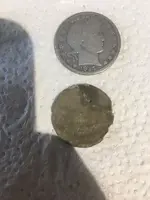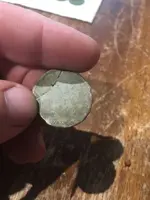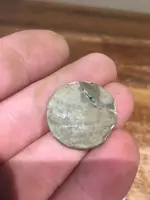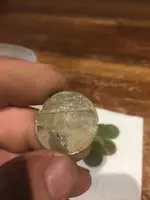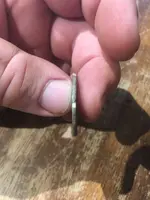You are using an out of date browser. It may not display this or other websites correctly.
You should upgrade or use an alternative browser.
You should upgrade or use an alternative browser.
Unknown coin I think..
- Thread starter Kingrich
- Start date
bradyboy
Silver Member
- Joined
- Apr 15, 2007
- Messages
- 3,518
- Reaction score
- 1,361
- Golden Thread
- 0
- Location
- Clearwater, FL
- Primary Interest:
- All Treasure Hunting
I think I see 2 pillars ?
Upvote
0
tomsneck
Sr. Member
- Joined
- Feb 15, 2007
- Messages
- 407
- Reaction score
- 598
- Golden Thread
- 0
- Location
- marthas vineyard
- Detector(s) used
- Whites xlt, mxsport
What did it ring out of the hole?
Upvote
0
- Joined
- Jun 8, 2006
- Messages
- 6,408
- Reaction score
- 9,239
- Golden Thread
- 0
- Location
- Upstate South Carolina
- Detector(s) used
- Whites, Minelab, Tesoro, and custom machines
- Primary Interest:
- Metal Detecting
The way it's cracked makes it look like zinc or pot metal?
Almost looks like lead where the crack is....
Upvote
0
Truth
Gold Member
I’ve only found one Seated coin and it was counterfeit 1875 Seated Dime. 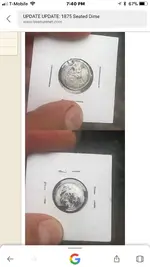
I sent these pictures to a counterfeit expert and he sent me this.
“This one looks like a cast example using antimony. Antimony is quite brittle and these piece easily cracked. It is a contemporary piece which means made at roughly the same time as the date on the coin."
Sent from my iPhone using Tapatalk

I sent these pictures to a counterfeit expert and he sent me this.
“This one looks like a cast example using antimony. Antimony is quite brittle and these piece easily cracked. It is a contemporary piece which means made at roughly the same time as the date on the coin."
Sent from my iPhone using Tapatalk
Upvote
0
steelheadwill
Gold Member
- Joined
- Jan 2, 2010
- Messages
- 6,689
- Reaction score
- 716
- Golden Thread
- 1
- Location
- New Castle NH.
- 🥇 Banner finds
- 1
- Detector(s) used
- Brain eyes ears and nose
- Primary Interest:
- Other
Some contemporary counterfeits I've recovered show the single raised line as does yours.
It's common enough that I believe it's a result of something in the clandestine manufacture process.
I had 12 different ones (mostly GII 1/2d copies) analyzed with XRF spectroscopy, all were composed of lead or lead/tin alloys (aka pewter)
with minor amounts of other elements.(inc. Sb, antimony)
I was told that the more minor elements present, the older the object likely is, makes sense to me because refining advances have resulted in availability of purer metals.
I think most early coin copiers used whatever scraps on hand for the crucible.
Want more period fakes? I often find them in the water near small bridges, as tollbooths would often be located here, and tollkeepers knew coinage better than most, apparently tossing these fakes into the drink.
unfortunately, many will have been cancelled by holing or flattening.
occasionally a beauty will be found, I have 2 exceptional GIIs, date showing and well preserved by salt water.
(and dozens of lesser, though identifiable coins)
Lead, pewter, and high carat gold being the only metals the sea treats kindly, most pewter blisters, but hard black blister is preferable to the flaking soft tan consistency of dry land recoveries imo.
It's common enough that I believe it's a result of something in the clandestine manufacture process.
I had 12 different ones (mostly GII 1/2d copies) analyzed with XRF spectroscopy, all were composed of lead or lead/tin alloys (aka pewter)
with minor amounts of other elements.(inc. Sb, antimony)
I was told that the more minor elements present, the older the object likely is, makes sense to me because refining advances have resulted in availability of purer metals.
I think most early coin copiers used whatever scraps on hand for the crucible.
Want more period fakes? I often find them in the water near small bridges, as tollbooths would often be located here, and tollkeepers knew coinage better than most, apparently tossing these fakes into the drink.
unfortunately, many will have been cancelled by holing or flattening.
occasionally a beauty will be found, I have 2 exceptional GIIs, date showing and well preserved by salt water.
(and dozens of lesser, though identifiable coins)
Lead, pewter, and high carat gold being the only metals the sea treats kindly, most pewter blisters, but hard black blister is preferable to the flaking soft tan consistency of dry land recoveries imo.
Last edited:
Upvote
0
Similar threads
- Replies
- 30
- Views
- 2K
- Replies
- 2
- Views
- 697
Users who are viewing this thread
Total: 1 (members: 0, guests: 1)


